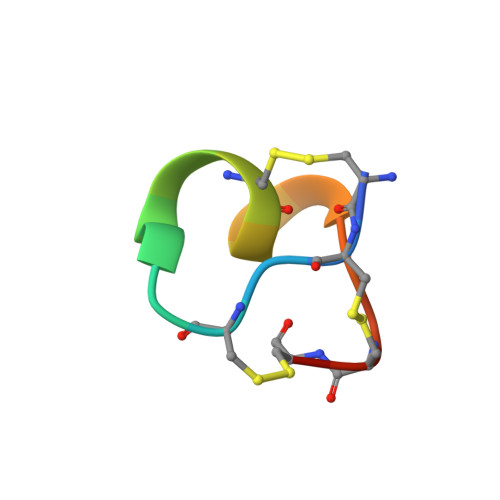Structural and functional insights into the inhibition of human voltage-gated sodium channels by mu-conotoxin KIIIA disulfide isomers.
Tran, H.N.T., McMahon, K.L., Deuis, J.R., Vetter, I., Schroeder, C.I.(2022) J Biol Chem 298: 101728-101728
- PubMed: 35167877
- DOI: https://doi.org/10.1016/j.jbc.2022.101728
- Primary Citation of Related Structures:
7SAV, 7SAW - PubMed Abstract:
μ-Conotoxins are components of cone snail venom, well-known for their analgesic activity through potent inhibition of voltage-gated sodium channel (Na V ) subtypes, including Na V 1.7. These small, disulfide-rich peptides are typically stabilized by three disulfide bonds arranged in a 'native' CysI-CysIV, CysII-CysV, CysIII-CysVI pattern of disulfide connectivity. However, μ-conotoxin KIIIA, the smallest and most studied μ-conotoxin with inhibitory activity at Na V 1.7, forms two distinct disulfide bond isomers during thermodynamic oxidative folding, including Isomer 1 (CysI-CysV, CysII-CysIV, CysIII-CysVI) and Isomer 2 (CysI-CysVI, CysII-CysIV, CysIII-CysV), but not the native μ-conotoxin arrangement. To date, there has been no study on the structure and activity of KIIIA comprising the native μ-conotoxin disulfide bond arrangement. Here, we evaluated the synthesis, potency, sodium channel subtype selectivity, and 3D structure of the three isomers of KIIIA. Using a regioselective disulfide bond-forming strategy, we synthetically produced the three μ-conotoxin KIIIA isomers displaying distinct bioactivity and Na V subtype selectivity across human Na V channel subtypes 1.2, 1.4, and 1.7. We show that Isomer 1 inhibits Na V subtypes with a rank order of potency of Na V 1.4 > 1.2 > 1.7 and Isomer 2 in the order of Na V 1.4≈1.2 > 1.7, while the native isomer inhibited Na V 1.4 > 1.7≈1.2. The three KIIIA isomers were further evaluated by NMR solution structure analysis and molecular docking with hNa V 1.2. Our study highlights the importance of investigating alternate disulfide isomers, as disulfide connectivity affects not only the overall structure of the peptides but also the potency and subtype selectivity of μ-conotoxins targeting therapeutically relevant Na V subtypes.
Organizational Affiliation:
Institute for Molecular Bioscience, The University of Queensland, St Lucia, Queensland, Australia.














